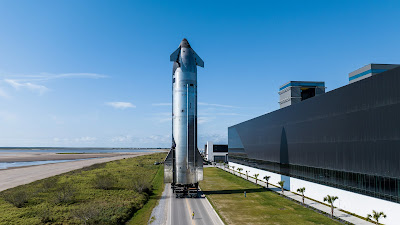SpaceX Futuristic Starship:
 |
| Image Courtesy: CNN |
• SpaceX is developing Starship, a powerful rocket that will transport people to Mars and beyond. However, building a new spaceship is not straightforward. Many tests fail before success. This happened with Starship prototypes SN7 and SN8, which both detonated! But why? Let us find out.
Starship SN7: An Intended Failure Test
 |
| Image Courtesy: SpaceX |
• Tank SN7 was only a test tank, not a complete rocket. SpaceX wanted to test a new kind of stainless steel on Starship in June 2020. Liquid nitrogen was poured into SN7, and the pressure was raised until it exploded.
• What caused it to blow up?
The purpose of the test was to test the tank's limits. Before it broke, engineers needed to know how much pressure it could withstand. SpaceX gained valuable information from the explosion that will help them create future, more robust tanks. SN7 exploded, but the test was successful! It assisted SpaceX in refining the design of Starship.
Starship SN8: A Big Leap, A Big Boom
 |
| Image Courtesy: SpaceX |
• With its three potent Raptor engines, it was the first full-size Starship prototype. It took off for a high-altitude test flight on December 9, 2020. The mission was thrilling:
✔️ The rocket exceeded a passenger airliner in altitude, reaching 12.5 km (41,000 feet)!
✔️ To control its fall, it tilted sideways in a "belly flop" movement.
✔️ It attempted to return to the launch pad.
• However, BOOM! When SN8 landed, it exploded. What caused SN8 to blow up? There was a fuel issue with the rocket's header tank. During the landing, the engines did not receive enough fuel. The explosion resulted from a strong touchdown. SpaceX declared the test successful despite SN8 blowing up. It demonstrated that Starship was capable of spaceship-like flight and maneuver!
What Did SpaceX Discover?
 |
| Image Courtesy: Grok |
• Every explosion gives SpaceX new knowledge. Through SN7 and SN8, they discovered: Improved stainless steel strengthens Starship tanks, while upgrades to the fuel system avoid low-pressure problems. To achieve a soft touchdown, landing techniques must be modified.
The Starship's Future Path
 |
| Image Courtesy: SpaceX |
• With each test, SpaceX keeps improving Starship. They constructed more prototypes after SN8's explosion, each of which addressed earlier problems. Although SN10 made a successful landing, a landing leg failure caused it to detonate a few minutes later.
• SpaceX was finally making headway when SN15 became the first Starship prototype to land and remain intact. What sets SpaceX apart is its testing, failure, and improvement approach. In contrast to conventional space organizations, they favor quick innovation through practical testing as opposed to honing plans solely on paper.
Why Starship’s Success Matters
 |
| Image Courtesy SpaceX |
• The success of Starship is not just important for SpaceX—it matters for the entire future of space travel. If SpaceX succeeds, Starship could make space missions cheaper, faster, and more frequent. This means more satellites, space tourism, Moon bases, and even human colonies on Mars.
• While explosions like SN7 and SN8 may seem like failures, they are actually steps toward a revolutionary future in space exploration. In the coming years, Starship could become the key to making space accessible to everyone, not just astronauts. The journey is tough, but as SpaceX has shown, failure is just another step toward success.
How SpaceX turns Failure into strength:
 |
| Image Courtesy SpaceX |
• SpaceX's distinct approach to failure is one of the main factors that make it stand out in the space sector. The business welcomes explosions as teaching moments rather than as losses. SpaceX has a different approach than traditional space projects, which spend years perfecting designs before launching.
• Instead, they test, fail, learn, and improve. They can advance quickly because of their quick development cycle. Every unsuccessful Starship test yields useful information that engineers can use to address problems and advance. The rapid improvement of Starship by SpaceX would not have been possible without the explosions of SN7 and SN8.
The secret to success is failure.
• Explosions don't scare SpaceX. They even anticipate them! Every test failure contributes to Starship's improvement. Better landings were made by SN9, SN10, and SN15 after SN8. Starship will eventually be prepared for actual missions.
We're Getting Nearer to Mars!
 |
| Image Courtesy Pinterest |
• The goal of SpaceX is to transport people to Mars. SN7 and SN8 failures are a natural part of the process. Starship gets stronger, better, and closer to creating history with every test!
Stay Connected with us, and Learn more interesting things with us.




.jpeg)


0 Comments